The AMD A8-7670K APU Review: Aiming for Rocket League
by Ian Cutress on November 18, 2015 8:00 AM ESTGaming Benchmarks: Low End
To satisfy our curiosity regarding low-power gaming, as well as dual graphics arrangements, we ran our regular suite through each processor. On this page are our integrated graphics results, along with a cheaper graphics solution in the R7 240 DDR3 and, in the case of AMD, both of these together in dual graphics mode.
Alien: Isolation
If first-person survival mixed with horror is your sort of thing, then Alien: Isolation, based off of the Alien franchise, should be an interesting title. Developed by Creative Assembly and released in October 2014, Alien: Isolation has won numerous awards, ranging from Game Of The Year to several top 10s/25s and Best Horror titles, ratcheting up over a million sales by February 2015. Alien: Isolation uses a custom-built engine that includes dynamic sound effects and should be fully multicore enabled.
For low-end graphics, we test at 720p with Ultra settings, whereas for mid- and high-range graphics, we bump this up to 1080p, taking the average frame rate as our marker with a scripted version of the built-in benchmark.

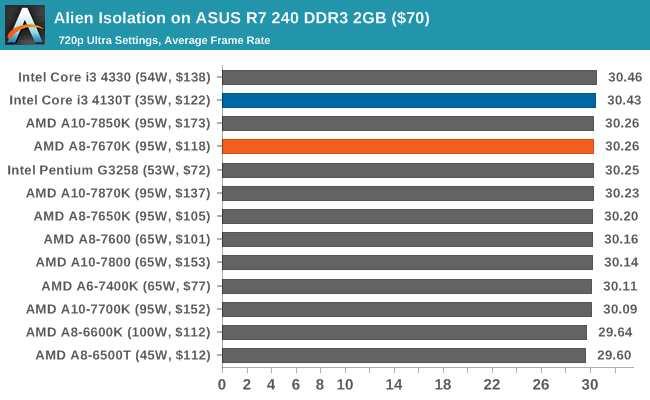
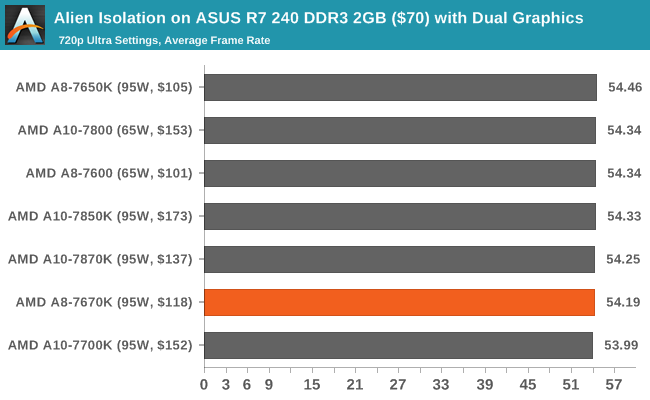
Total War: Attila
The Total War franchise moves on to Attila, another Creative Assembly development, and is a stand-alone strategy title set in 395AD where the main story line lets the gamer take control of the leader of the Huns in order to conquer parts of the world. Graphically, the game can render hundreds/thousands of units on-screen at once, all with their individual actions, and can put some of the big cards to task.
For low-end graphics, we test at 720p with performance settings, recording the average frame rate. With mid- and high-range graphics, we test at 1080p with the quality setting. In both circumstances, unlimited video memory is enabled, and the in-game scripted benchmark is used.
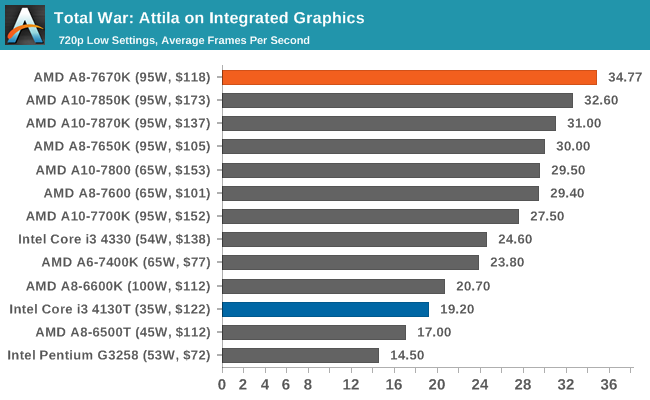

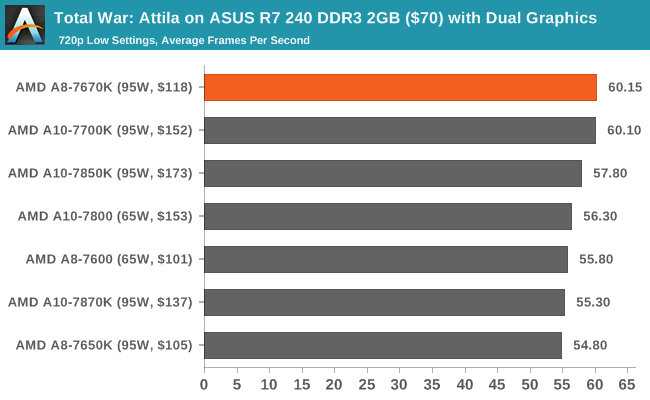
Grand Theft Auto V
The highly anticipated iteration of the Grand Theft Auto franchise finally hit the shelves on April 14, 2015, with both AMD and NVIDIA in tow to help optimize the title. GTA doesn’t provide graphical presets, but it opens up the options to users and extends the boundaries by pushing even the hardest systems to the limit using Rockstar’s Advanced Game Engine. Whether the user is flying high in the mountains with long draw distances or dealing with assorted trash in the city, when cranked up to maximum, it creates stunning visuals but hard work for both the CPU and the GPU.
For our test, we have scripted a version of the in-game benchmark, relying only on the final part, which combines a flight scene with an in-city drive-by, followed by a tanker explosion. For low-end systems, we test at 720p on the lowest settings, whereas mid- and high-end graphics play at 1080p with very high settings across the board. We record both the average frame rate and the percentage of frames under 60 fps (16.6 ms).

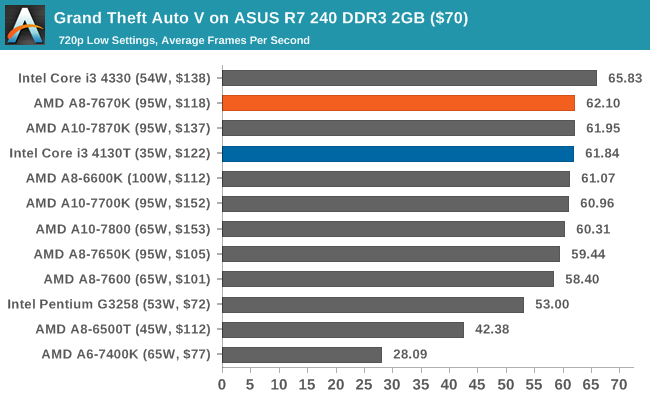
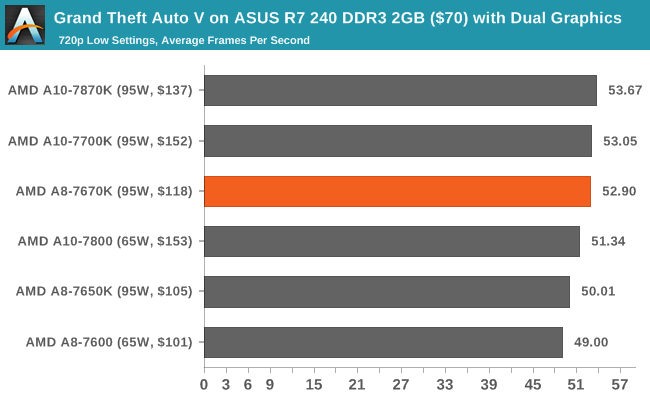
GRID: Autosport
No graphics test is complete without some input from Codemasters and the Ego engine, which means for this round of testing, we point toward GRID: Autosport, the next iteration in the GRID and racing genre. As with our previous racing testing, each update to the engine aims to add in effects, reflections, detail and realism, with Codemasters making "authenticity" a main focal point for this version.
GRID’s benchmark mode is very flexible, and as a result, we created a test race using a shortened version of the Red Bull Ring with 12 cars doing two laps. The player car is in focus throughout this benchmark and starts last, but usually finishes second or third. For low-end graphics, we test at 1080p and medium settings, whereas mid- and high-end graphics get the full 1080p maximum. Both the average and the minimum frame rates are recorded.
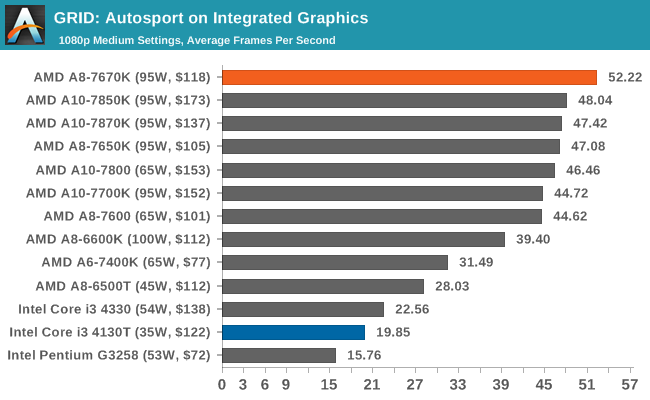
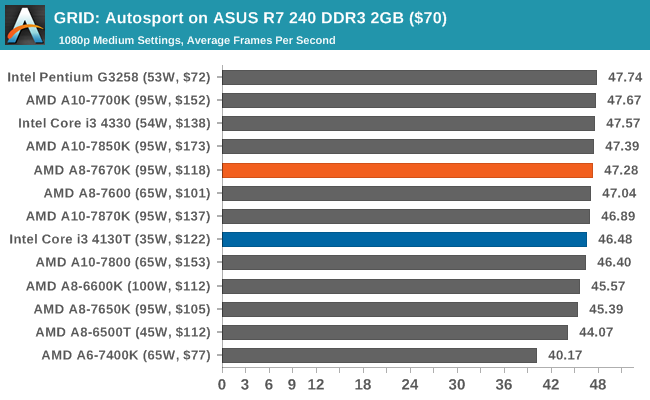
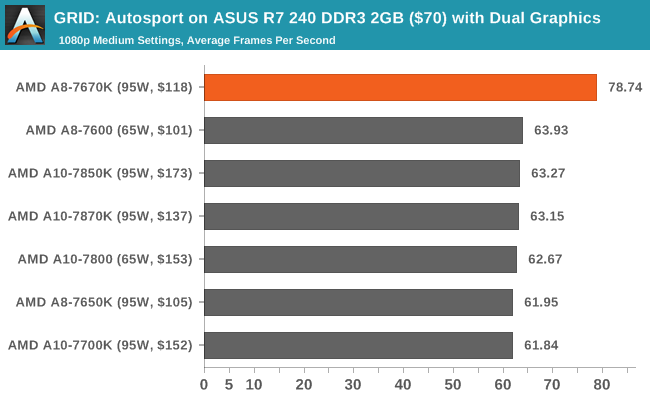
For whatever reason, the A8-7670K gets a good showing in the integrated tests, especially in dual graphics mode, with an abnormally high score. Some other issue might be at play here and warrants further testing.
Middle-Earth: Shadows of Mordor
The final title in our testing is another battle of system performance with the open-world action-adventure title Shadow of Mordor. Produced by Monolith using the LithTech Jupiter EX engine and numerous detail add-ons, SoM goes for detail and complexity to a large extent, despite having to be cut down from the original plans. The main story was written by the same writer as Red Dead Redemption, and it received Zero Punctuation’s Game of The Year in 2014.
For testing purposes, SoM gives a dynamic screen resolution setting, allowing us to render at high resolutions that are then scaled down to the monitor. As a result, we get several tests using the in-game benchmark. For low-end graphics, we examine at 720p with low settings, whereas mid- and high-end graphics get 1080p Ultra. The top graphics test is also redone at 3840x2160, also with Ultra settings, and we also test two cards at 4K where possible.
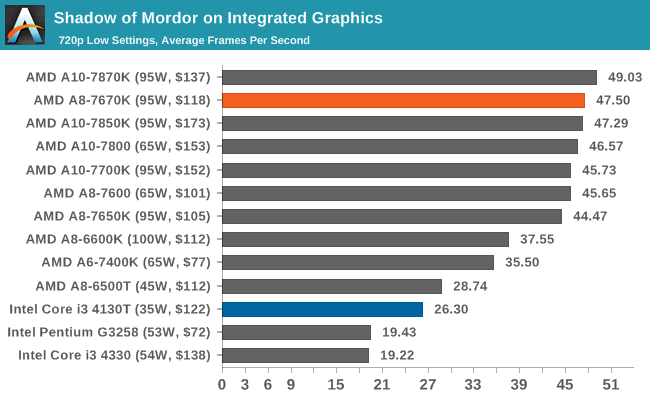
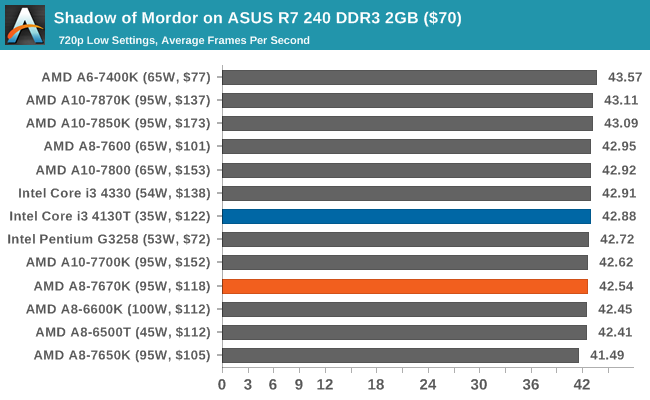
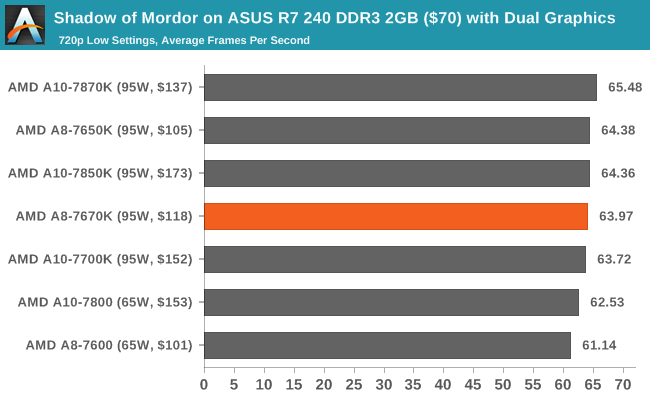















154 Comments
View All Comments
tipoo - Wednesday, November 18, 2015 - link
The FPS by percentile graph is nice, is that new to AT?Ian Cutress - Wednesday, November 18, 2015 - link
Ryan does some percentile data in GPU reviews, and we did some stuff around the CFX/SLI sync issues. But we did the FPS by percentile graphs a bit in the Fable Legends testing. Some benchmarks provide the per-frame data by default, others do not (depends on how you're polling), and then there's some post-processing which takes longer than you think. It's a sort of graph that only 3/4 lines can be on it without going overboard.tipoo - Wednesday, November 18, 2015 - link
Cool. I like it.tipoo - Wednesday, November 18, 2015 - link
For GTA V, it looks like dual graphics on the same settings gives lower framerates than the 240 alone? Is that right? Other than that you see a pretty nice boost with it.jaydee - Wednesday, November 18, 2015 - link
I noticed that too and was wonderingyannigr2 - Wednesday, November 18, 2015 - link
APUs are excellent solutions for systems without graphics. If you are going to add a graphics card, then excluding dual graphics, APUs seem much less attractive. A8 7600 is in my opinion the best cheap APU you can get for a system without a discrete graphics card, 78X0K are an option ONLY when you are definitely never going to add a graphics card and you want the best possible integrated GPU, without having to rob a bank for an Iris GPU.But even when AMD's APUs are the best option, people will still rush to make people avoid them. That's AMD's doing and we can only blame them. Recently someone asked for a cheap system to play an old FPS game. Videos on youtube where showing that an A8 7600 could play the game. That didn't stopped people rushing in the thread to insist that, that game wasn't going to be fun with under 140 fps. Yes, 140 fps. They didn't considered gaming peripherals, or a gaming monitor important, only 140 fps. Anything to "save" someone from an AMD APU and send him to Intel. Even if this means convincing someone paying at least $80-$100 that he may not have. At the same time the same persons blame ONLY AMD for the lack of competition.
Dribble - Wednesday, November 18, 2015 - link
AMD's solutions appeal to pretty well no one. If you don't have an add in gpu chances are you don't want to game in which case Intel wins hands down. If you want to game you'll buy a cheap graphics card in which case Intel wins hands down.The mythical buying market that want to game on a desktop but can't even afford a basic add on card just doesn't exist. We know this because AMD have been trying to sell apu's like this one for years now and no one is buying.
Yorgos - Wednesday, November 18, 2015 - link
That's false,I am gaming in 1080p and I play many games above 25fps with almost high settings.
A good example is skyrim with the high definition mod that you can get from steam and I am constantly at 25 fps.
All this was tested on my 8750k and 2400 MHz ram. What's your point of reference?
OTOH, there is a shitload of ppl that play only MOBA games or FPS like cs where you don't need to spend 300 or more in a system. A 150$ system can get you constant 30 fps w/o a sweat.Plus you get a discrete grade GPU embedded with your cpu and you get all the goodies and the high quality drivers/support the discrete gpus get. Intel has none of the previous.
Dribble - Wednesday, November 18, 2015 - link
I would point you to AMDs CPU sales. No one is buying, AMD have been trying to sell cpu's like this one for years and failing - the market isn't there.medi03 - Thursday, November 19, 2015 - link
I would point you to the fact that Netburst outsold superior Athlon 64s 4 to 1.